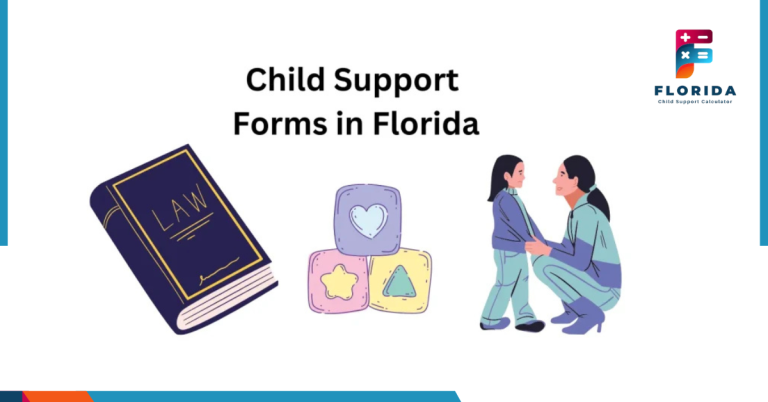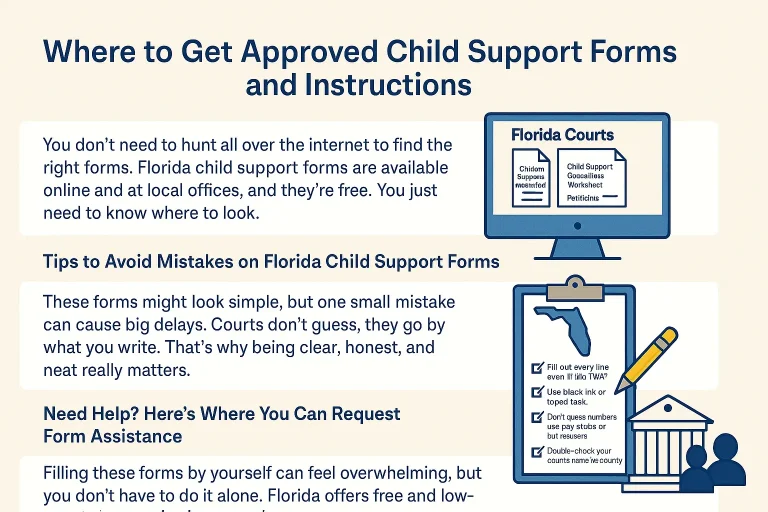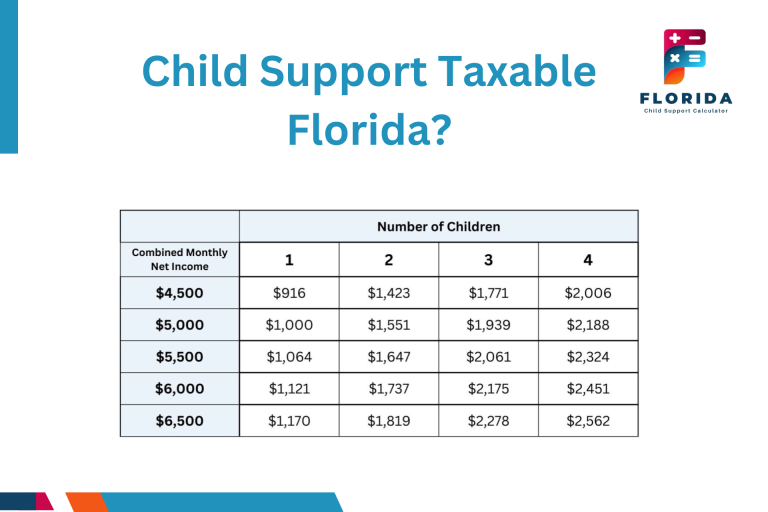Child Support Forms in Florida
Filling out child support forms in Florida can feel like trying to read a secret code. But don’t worry, you’re not alone, and this guide breaks everything down into simple steps. Whether you’re dealing with a new support case or trying to respond as the other parent, you’ll find all the forms and help you need right here.

We’ll walk through important packets like the IV-D Child Support Respondent’s Packet and explain what to do before filing a motion. You’ll also learn how child support is calculated and what to avoid when filing. Think of this as your step-by-step map through the maze of Florida child support guidelines.
What Is a Child Support Respondent’s Packet? (IV-D Explained)
If you just got served with child support papers in Florida, you’re called the respondent, and the IV-D Child Support Respondent’s Packet is what you need. It’s a bundle of legal forms that tells you how to reply, what documents to fill out, and where to send them.
The packet usually comes from the Florida Department of Revenue, and it includes forms like the financial affidavit, the UCCJEA affidavit, and information about your rights. This isn’t just paperwork, it’s how you protect yourself and your child in court. Sometimes, it’s linked to how income is calculated for child support, so take it seriously.
Make sure you read the packet before the court deadline. If you ignore it, the judge might decide everything without hearing your side.
Forms You’ll Usually Find in a Child Support Case
Most child support forms in Florida show up again and again in every case, whether you’re asking for support or replying to a request. These forms help the court figure out who owes what, how much, and why. Think of them like puzzle pieces that fit together to show your full story. Here’s a list of the common forms and what they do:
| Form Type | Purpose | Used For |
|---|---|---|
| Petition for Child Support | Starts a new case | Custodial parent requesting support |
| Financial Affidavit | Shows income and expenses | Required for all support cases |
| UCCJEA Affidavit | Confirms the child’s residence history | Custody and support jurisdiction |
| Guidelines Worksheet | Calculates the support amount | Florida child support guidelines |
| Income Deduction Order | Allows wages to be taken automatically | Enforcing unpaid child support |
A missing form or wrong number can delay everything. So double-check before filing.
Forms Every Respondent Needs to Know (Don’t Skip These!)
When you’re the respondent in a child support case, there are specific forms made just for your side of the story. These are the tools that help you explain your situation, fix mistakes, or respond to the other parent’s claims. Skipping any of them is like going into a game without reading the rules.
The general instructions for motions and respondents’ forms usually include steps for what to file, how to send it, and what supporting documents are required. One common form you’ll use is the Respondent’s Motion to Dismiss, which is useful if the other parent filed something incorrectly.
Sometimes, these forms connect to changes in your job or income. That’s when the child support modification process becomes important, too. Judges don’t guess, they go by what’s written on these forms.
General Instructions: Before You File Any Motion or Petition
Filing a motion or petition in a Florida child support case isn’t just filling out a form, it’s like making your voice heard in court. But before you speak, you need to know the rules. That’s where the general instructions come in.
At the start, make sure you have everything the court needs. If you’re not sure how Florida child support is calculated, that’s a good place to check before filling out your worksheet. You’ll also want to look at the minimum child support rules so you don’t guess the wrong numbers. These instructions explain how to serve papers, where to sign, and what supporting documents go with your form.
Skipping this part is like baking without reading the recipe; something important might be left out.
Most Common Motions and Petitions in Florida Child Support Cases
In Florida, parents use motions and petitions when they want the court to change something or fix a problem. A petition is how you start a case. A motion is how you ask for a change after the case has started.
If one parent loses their job, they might file a petition to reduce child support. That’s a big deal and needs proper paperwork. If the other parent hasn’t paid, you could file a motion for enforcement or even contempt, and yes, that can lead to jail time for unpaid child support. Here are a few common ones:
- Petition to Establish Support
- Motion to Modify Child Support
- Motion for Temporary Relief
- Motion for Civil Contempt
- Petition to Establish Paternity
These motions help the court understand your side, especially if things have changed since the original order.
Want the Court to Act? These Are the Motions You’ll Use
Sometimes, just being in court isn’t enough. If you want the judge to actually do something, like force the other parent to respond, you’ll need the right motion. These special forms are how you say, “Hey judge, please take action!”
Start by filing the right paperwork. The Child Support Enforcement section can be useful if you’re dealing with non-payment. If your ex isn’t answering or keeps delaying, a motion to compel or a motion for default might be the way to go. These are smart tools for tough situations.
| Motion Name | Use It When |
|---|---|
| Motion to Compel | The other parent isn’t responding |
| Motion for Default | They ignored court deadlines |
| Motion for Clarification | You don’t understand a court order |
| Motion for Continuance | You need more time to prepare |
Sometimes these motions go with a child support modification request, especially if someone asks for more time to update their financials.
Where to Get Approved Child Support Forms and Instructions
You don’t need to hunt all over the internet to find the right forms. Florida child support forms are available online and at local offices, and they’re free. You just need to know where to look.

At the Florida Courts website, you’ll find approved family law forms, like the Child Support Guidelines Worksheet and Petitions. These forms match court rules, so they’re safe to use. For things related to how child support is calculated, the Department of Revenue (DOR) also has downloadable forms and instructions.
If you prefer paper copies, visit your county’s Clerk of Court office. Many even have printed packets ready to go.
Tips to Avoid Mistakes on Florida Child Support Forms
These forms might look simple, but one small mistake can cause big delays. Courts don’t guess, they go by what you write. That’s why being clear, honest, and neat really matters.
A common issue is using the wrong income numbers. To get it right, check out how income is calculated for child support. Also, don’t forget that support amounts can be affected by shared parenting or custody, so knowing the child support laws in Florida helps, too. Here are a few quick tips:
- Fill out every line, even if it’s “N/A.”
- Use black ink or typed text
- Don’t guess numbers, use pay stubs or tax returns
- Double-check your court’s name and county
Need Help? Here’s Where You Can Request Form Assistance
Filling these forms by yourself can feel overwhelming, but you don’t have to do it alone. Florida offers free and low-cost help to make things easier.
Start by visiting a family law self-help center in your county. Many people also check the contact page of their local Clerk of Court for support. These offices sometimes have someone on-site to explain what each form means or check if you’ve missed something.

Legal aid groups also help, especially if you’re low-income. If you’re filing a motion to reduce child support, they can help fill in the financial affidavit correctly so you don’t miss your chance.
Supporting Documents That Often Go With These Forms
When you file child support forms in Florida, the paperwork doesn’t stop there. The court also wants proof, things that show what you earn, what you spend, and how your child is cared for. These are called supporting documents, and they help the judge make fair decisions.
Start with your pay stubs. The court checks your income using tools like the child support calculator, so real numbers matter. You might also need daycare receipts, proof of health insurance, and a copy of any modification request if your case is about changing support.
Make copies of everything. If you don’t show proof, your side of the story might not count in court.
Florida Child Support Laws That Affect Your Forms
Before you fill out a single form, it helps to understand the Florida child support laws behind them. These rules decide who pays, how much, and for how long. If you know the law, your forms will be easier to complete and more accurate.
According to Florida child support guidelines, both parents must help with expenses. That includes school costs, healthcare, and even housing. And if both parents work, yes, child support can still apply.
These laws also cover when support can change, like if someone loses a job or gets more parenting time. That’s why matching your forms to the right law is a smart move.
FAQs About Florida Child Support Forms
People ask a lot of the same questions when filling out child support forms in Florida, and for good reason. The process can be confusing without help.
Q1: Can I file without a lawyer?
Yes, you can. Most forms come with instructions, and self-help resources are available at local courthouses. Still, in complex cases, a lawyer might be helpful.
Q2: What if I make a mistake on the form?
If it’s a small mistake, like a typo, you may be able to fix it. But big errors, like wrong income, can affect your case. The court uses forms like the Income Calculated Deduction Order to decide payments, so accuracy really matters.
Q3: Can I get help filling them out?
Yes! Legal aid clinics and some Clerk of Court offices help people complete forms, especially if you qualify for free services.
Conclusion
Let’s be honest, no one wants to deal with forms, especially when they decide something as big as child support. But once you know what each paper means and where to send it, it’s not as scary as it seems. You’re not just filling blanks, you’re building a case for your child’s future.
At the beginning, tools like the Florida child support calculator can give you a good idea of what to expect. Later on, if life changes, forms for modifying child support are available, too.
No matter where you are in the process, starting a case, responding to one, or asking the court to act, having the right forms (and using them correctly) keeps things fair, legal, and smooth for everyone involved.






